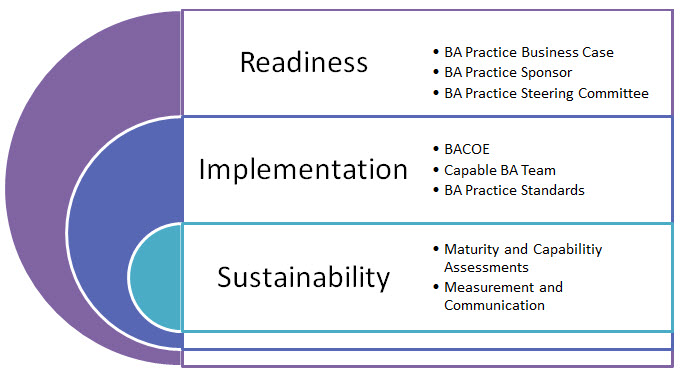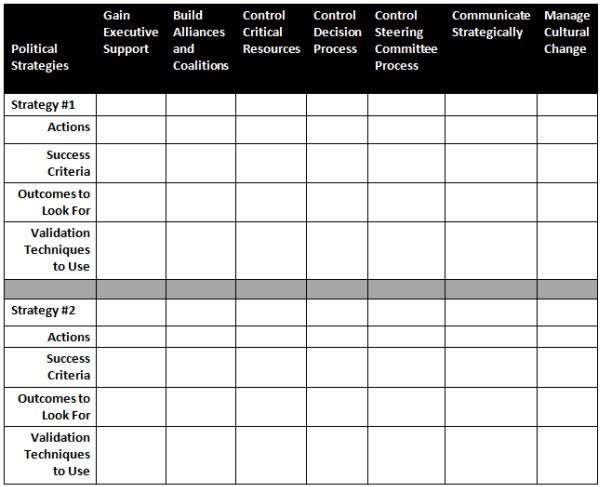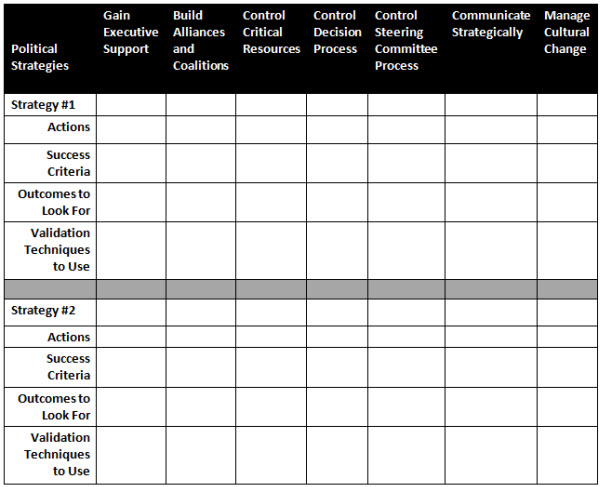 In the previous articles, we discussed the reasons Business Analysis (BA) is emerging as a critical business process, and the value of Enterprise BAs. However, organizations are experiencing lots of challenges attempting to implement an effective BA Practice. In this article, we will examine some of the fundamental building blocks that will enable you to be successful in creating and sustaining a mature BA Practice.
In the previous articles, we discussed the reasons Business Analysis (BA) is emerging as a critical business process, and the value of Enterprise BAs. However, organizations are experiencing lots of challenges attempting to implement an effective BA Practice. In this article, we will examine some of the fundamental building blocks that will enable you to be successful in creating and sustaining a mature BA Practice.
Is Your Organization Ready?
For decades businesses that are dependent on complex projects for their success have been challenged to deliver. They primarily focused on requirements for IT solutions and managing (aka, limiting) changes to those requirements, (mostly thought of as scope creep). Finally, the relatively new discipline of Business Analysis changes the project focus from IT to the business. After all is said and done, it is about the business value brought about by new IT solutions, not about the technology.
While there are some world-class BA Practices in existence, far too many attempts to implement a Business Analysis Practice have been only marginally successful. Too often the improvements to BA have been driven exclusively from the bottom up. While support is needed from all levels of the organization, grassroots efforts tend to be project specific, and disappear gradually as project teams are disbanded.
BA Practice Implementation and Sustainability
To implement and institutionalize an enterprise-wide BA Practice, the business value that is promised from a mature BA Practice needs to be fully understood across the organization, and BA benefits need to be continually demonstrated through measurement and communication programs. Leadership and sponsorship of the effort should emanate from the top of the organization, and flow down to all levels. A holistic and methodical implementation approach and framework is essential for success and sustainability. Mature BA Practices have several components: a capable BA team, organizational support, executive leadership and sponsorship, and an implementation and sustainability framework.
Typically, a BA Practice is supported by a number of integrated elements that comprise a holistic framework. To deal with the significant amount of change required by all project stakeholders, the BA Practice implementation should be managed in phases. The value of the BA Practice needs to be demonstrated and communicated during every phase.
Initial Readiness Phase
Answers the question, “Is our organization ready?”
- Business Case
- Executive Sponsor
- Steering Committee
Subsequent Implementation Phase
Answers the question, “How do we build the BA Practice?”
- The BA Center of Excellence (BACOE)
- Capable BA Team
- BA Practice Standards
Ongoing Sustainability Phase
Answers the question, “How do we institutionalize and continue to improve BA practices?”
- Maturity and Capability Assessments and Continuous Improvements
- Measurement and Communication Programs
The BA Practice Framework
A brief description of the elements of the framework is provided below. Future articles will explore each element in detail.
The Business Case for a mature BA Practice
There are many elements that must be in place for you to declare your readiness to begin to implement a BA Practice. As we discussed in the previous article in this series, (Why Business Analysis? What’s in it for me?)
The most important tool in the Business Analysts’ arsenal is the Business Case. The life of every important change initiative begins and ends with a Business Case. Unless a change initiative (project) results in business benefits in terms of value to the customer and/or wealth to the bottom line, it is a failed venture – even if it is delivered on time and on budget. It is in the Business Case that the expected costs and business benefits are outlined. Without it, you are engaged in steering a rudderless vessel. Yet, in far too many projects, a Business Case does not exist. If it does exist, it is often unconvincing and used only to get funding for a project. The value of the Business Analyst is realized through execution and management of the Business Case….
Implementation of a new business process such as Business Analysis is a major change initiative. You will not get the organizational support you need unless you have a convincing Business Case. So, your first phase of the project is to engage a small but influential team of business and technical experts to work with you to build the Business Case for a Business Analysis Practice. It is imperative that you do not build the Business Case in isolation. Involving experts who are important leaders in the organization is critical. By involving experts, you will be building your team of high-level supporters.
You need to lead the group of experts to develop what is often referred to as a “Brilliant Business Case”. This is essentially an R&D, creative endeavor. The effort requires adequate time, a skilled facilitator (the BA Practice Lead), a strategic focus, and creative expert resources. The effort needs to be driven by you. The Business Case is owned by the BA Practice Lead; that is to say she authors and maintains the Business Case in collaboration with business and technology thought leaders. And subsequently, she must report against the cost and benefit projections contained in the Business Case. Be sure to capture the names and titles of the experts engaged to create the Business Case. This lends reliability and credibility to the proposal. If you would like to see a sample or rough draft of a Business Case to create an effective Business Analysis Practice, please send an email to [email protected].
The Executive Sponsor
Once you have developed the Business Case to implement a BA Practice, you should enlist an Executive Sponsor to guide the effort, to own the budget for the BA Practice, and to commit to the cost and benefit projections. Usually, the executive sponsor is a very senior-level executive, such as the CIO or CSO (Chief Strategy Officer).
The Executive Steering Committee
It is ideal to secure the approval of the experts who helped build the Business Case to serve on a BA Practice Steering Committee. The Steering Committee, facilitated by the BA Practice Lead and chaired by the Executive Sponsor, will provide political cover, decision support, budget, and legitimacy to the BA Practice initiative.
The BA Center of Excellence
The BA Practice needs a home, a department that is accountable and responsible for building and sustaining an effective BA Practice. This center should be small (too large is deadly), and is authorized to manage the BA team, the business case process, organizational BA standards and frameworks, methods, training, tools, templates, techniques and BA metrics and communication.
Capable BA Team
Today, BAs are mostly project focused, creating and managing requirement artifacts. However, to become a valuable corporate asset, BAs need to become strategically focused, concentrating on innovative solutions to complex business problems.
BA Practice Standards
In days gone by, we always followed the maxim, process first, then tools. The good news is that BA tools have grown up. Good BA standards are now embedded in integrated requirements management tools. So the tool helps educate BAs on the best practices, integrate and manage the requirements knowledge and artifacts, and helps forward engineer information into BA artifacts.
The bad news is most BAs still use desk top tools that are difficult to maintain and are disintegrated. As a result, the BA is burdened with creating, maintaining, integrating, and synchronizing all of the business strategies, goals, models, documents, matrices, use cases, user stories, test cases, etc. Adopt sophisticated tools to maintain reusable requirement artifacts, impose standards and enable education.
Maturity and Capability Assessments and Continuous Improvements
It is often said: we don’t need to do a maturity assessment, because we know our capabilities are immature. The problem is, just knowing your capabilities are immature is not actionable. Assessments provide useful information about strengths, and gaps that need immediate improvement to grow to the next level of maturity. Assessments shed light on exactly where you are, provide a step-by-step improvement roadmap, and facilitate continuous improvements based on proven maturity models.
Measurement and Communication Programs
Measurement and communication are key components of any change initiative. Make no mistake; implementing a mature BA Practice is no small endeavor. The effort is fraught with challenges. Targeted communications tailored to the needs of each stakeholder group is essential. The messages need to demonstrate the real business value brought about by improvement BA practices.
Putting it all Together
So what does this mean for the Business Analyst?
If you are trying to implement BA best practices, methodologies, frameworks, and enabling technologies on your project, good for you! Don’t get discouraged by realizing these may die on the vine when your project is completed. Collaborate with others outside of your project to expand your reach and build lasting momentum.
So what does this mean for the BA Practice Lead?
This article presents the case for a BA framework to implement an enterprise-wide mature BA Practice that is strategically focused. In the next article, we will focus on you, the BA Practice Lead: are you ready?
Don`t forget to leave your comments below.




 In the previous articles, we discussed the reasons Business Analysis (BA) is emerging as a critical business process, and the value of Enterprise BAs. However, organizations are experiencing lots of challenges attempting to implement an effective BA Practice. In this article, we will examine some of the fundamental building blocks that will enable you to be successful in creating and sustaining a mature BA Practice.
In the previous articles, we discussed the reasons Business Analysis (BA) is emerging as a critical business process, and the value of Enterprise BAs. However, organizations are experiencing lots of challenges attempting to implement an effective BA Practice. In this article, we will examine some of the fundamental building blocks that will enable you to be successful in creating and sustaining a mature BA Practice.